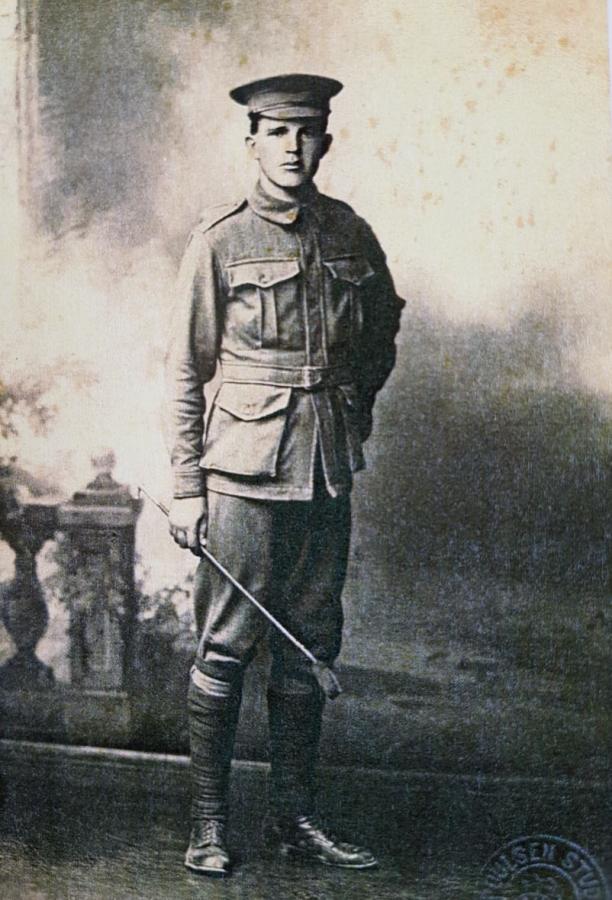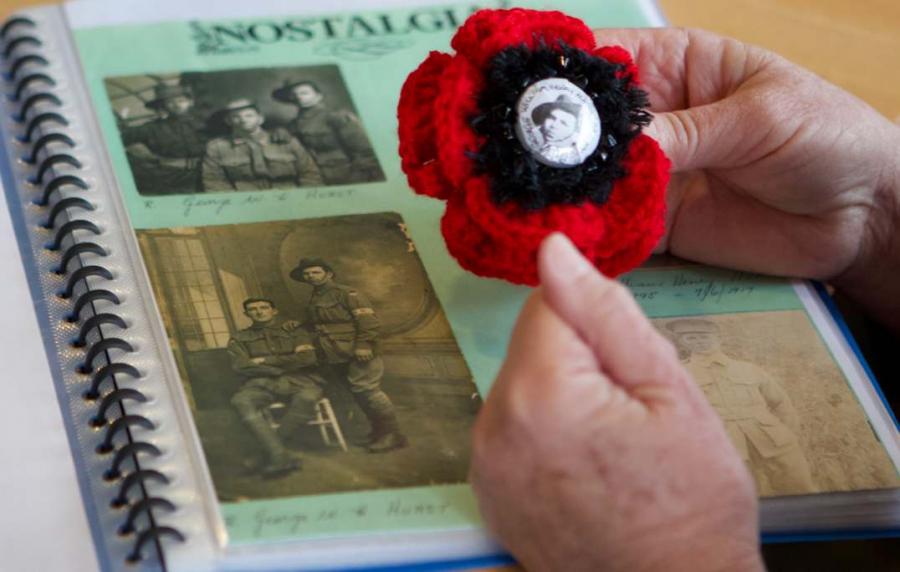'This is the closest we will come to putting a flower on his grave'

George Hurst, standing, in a studio portrait taken during the war. Photo: Courtesy Anita Shooks
When Anita Shooks heard about plans to install 62,000 handcrafted poppies in the grounds of the Australian War Memorial, to mark the centenary of the Armistice that ended the First World War, she knew exactly what she wanted to do.
She decided to make a special poppy in memory of her grandmother’s brother, Private George William Henry Hurst, who was killed in action at Messines on 7 June 1917 and has no known grave.
“This is the closest we will come to putting a flower on his grave,” Anita said. “He, and two of his brothers, went away to war, and Tom and Victor came back very badly injured. But George basically disappeared, and they couldn’t get any real answers from the government at the time about where he was or what had happened.”

Private George William Henry Hurst was killed in action at Messines on 7 June 1917. Photo: Courtesy Anita Shooks
Anita Shooks is one of more than 50,000 volunteers from around the world who have been lovingly knitting and crocheting poppies as part of the 5,000 Poppies project.
The project started as a small personal tribute by co-founders Lynn Berry and Margaret Knight to honour their fathers’ service during the Second World War. But it soon grew into a world-wide community project, culminating in a moving display of 62,000 poppies at the Memorial for Remembrance Day 2018.
As part of the Memorial’s commemorative program, more than 4,000 square metres of the Memorial’s grounds have been transformed into a field of red, with each handcrafted poppy symbolising an Australian life lost during the bloody conflict.
“The women in the 1900s would knit socks and things for the soldiers, so this is like carrying on that tradition,” Anita said. “Being made by hand, it gives you that link to the past … And, for us, the poppies are a way of commemorating the men who fought, so it’s pretty special.”

Anita’s great-uncle George enlisted in Queensland in September 1915 and served with the 49th Battalion on the Western Front.
“He was with a man by the name of Percy Cash, and they were stretcher-bearers,” Anita said. “He’d been through Pozières and all those sorts of places and had survived, but as stretcher-bearers they were extremely vulnerable. He was trying to pretend to his mother that the war wasn’t troubling him, but of course it was.”
On 2 June 1917, he wrote: “My dear mother, just a postcard to let you know that I am well, trusting it will find you all well. This is me and one of my mates. You can see by my dial that the war is not troubling me too much. I saw Tom [his younger brother] a few days ago and he is doing well.”
Less than a week later he was dead.

George Hurst, right, during the war. Photo: Courtesy Anita Shooks
A lieutenant, R.W. Argue of the 49th Battalion, later wrote: “Words would fail me to express the grand work down by Private Cash and his mate Private Hurst in rescuing and attending to wounded, day and night, during the Messines battle. Private Cash was killed together with his mate Private Hurst as they were leaving the front line after being relieved. He was one of the bravest and best men in the battalion and if he and his mate had come out of the battle alive [they] would certainly have been awarded some distinction for their gallantry and devotion to duty.”
George was just 22 years old, and today, his name is listed on the Menin Gate Memorial to the missing at Ypres, which bears the names of more than 54,000 soldiers who have no known grave.
“He was a descendant of convicts, his mother was illiterate, and he was born in Gulargambone in the central-west plains of NSW, so you couldn’t get any more Australian,” Anita said.
“He was the first in the family to join up – my grandmother joined up during the Second World War, but I get the impression he was a very quiet and unassuming person. His father, John, had died only months before the outbreak of the war, leaving George’s mother, Caroline, to raise eight children on her own. Even into old age, she would scrub floors to earn money, so things would have been pretty tough.”

Anita grew up hearing about her great-uncle George and was particularly moved by the chance to create a poppy in his honour.
“It was always a bit of a cloud, because they never really knew what had happened to him, and that has been passed down through the generations,” she said.
“We can’t put a flower on his grave because he just disappeared, so it was very, very difficult for the family. He has no known grave and I’ve made that poppy especially for George so that he will be remembered.”
For Anita, it is important to remember their service and sacrifice.
“He gave his life and he can’t just be forgotten,” she said. “It was a life cut short and I think he needs to be recognised and honoured for what he did.
“And that’s what it’s all about – the Georges in this world.”
The 62,000 Poppies display will be open from 9 am to 10 pm daily from now to 11 November as part of the Memorial’s five-week Honour their Spirit commemorative program marking the centenary of the Armistice on Remembrance Day 2018.